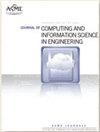面向制造业工业扩展现实的数据与模型互操作性研究
IF 2.6
3区 工程技术
Q2 COMPUTER SCIENCE, INTERDISCIPLINARY APPLICATIONS
Journal of Computing and Information Science in Engineering
Pub Date : 2023-04-17
DOI:10.1115/1.4062328
引用次数: 1
摘要
扩展现实(XR)技术已经实现了设计、制造和维护过程的重要价值。然而,由于数据、模型和平台之间的互操作性存在根本差距,工业XR或在工业应用程序中实现的XR在可伸缩性和灵活性方面面临挑战。尽管最近已经有许多努力来提高工业XR技术的互操作性,但领域特定模型(例如,制造执行数据、材料规范和产品制造信息)与XR(通常是标准)过程(例如,多尺度空间表示和为运行时表示优化的数据格式)之间的固有分离阻碍了进展。在本文中,我们详细阐述了制造和可视化学术界可以围绕的有前途的研究方向和机会。为了建立这样的研究方向,我们(1)对已经建立的最先进的综述文章进行了元综述,这些综述文章已经对工业XR的应用领域(如维护、装配和检查)进行了深入调查;(2)将这些发现与美国国防部公开发布的优先事项进行了对比。我们希望我们提出的研究议程能够促进跨学术竖井的跨学科工作,例如,制造和可视化社区,并在由另一个社区领导的工作组中参与其中,例如,在标准开发组织中。本文章由计算机程序翻译,如有差异,请以英文原文为准。
Towards Data and Model Interoperability for Industrial Extended Reality in Manufacturing
Extended reality (XR) technologies have realized significant value for design, manufacturing, and sustainment processes. However, Industrial XR, or XR implemented within industrial applications, suffers from scalability and flexibility challenges due to fundamental gaps with interoperability between data, models, and platforms. Though there has been a number of recent efforts to improve the interoperability of industrial XR technologies, progress has been hindered by an innate separation between the domain-specific models (e.g., manufacturing execution data, material specifications, and product manufacturing information) with XR (often-standard) processes (e.g., multi-scale spatial representations and data formats optimized for run-time presentation). In this paper, we elaborate on promising research directions and opportunities around which the manufacturing and visualization academic community can rally. To establish such research directions, we (1) conducted a meta-review on well-established state-of-the-art review articles that have already presented in-depth surveys on application areas for industrial XR, such as maintenance, assembly and inspection and (2) mapped those findings to publicly published priorities from across the US Department of Defense. We hope that our presented research agenda will spur interdisciplinary work across academic silos, i.e., manufacturing and visualization communities, and engages either community within work groups led by the other, e.g., within standards development organizations.
求助全文
通过发布文献求助,成功后即可免费获取论文全文。
去求助
来源期刊
CiteScore
6.30
自引率
12.90%
发文量
100
审稿时长
6 months
期刊介绍:
The ASME Journal of Computing and Information Science in Engineering (JCISE) publishes articles related to Algorithms, Computational Methods, Computing Infrastructure, Computer-Interpretable Representations, Human-Computer Interfaces, Information Science, and/or System Architectures that aim to improve some aspect of product and system lifecycle (e.g., design, manufacturing, operation, maintenance, disposal, recycling etc.). Applications considered in JCISE manuscripts should be relevant to the mechanical engineering discipline. Papers can be focused on fundamental research leading to new methods, or adaptation of existing methods for new applications.
Scope: Advanced Computing Infrastructure; Artificial Intelligence; Big Data and Analytics; Collaborative Design; Computer Aided Design; Computer Aided Engineering; Computer Aided Manufacturing; Computational Foundations for Additive Manufacturing; Computational Foundations for Engineering Optimization; Computational Geometry; Computational Metrology; Computational Synthesis; Conceptual Design; Cybermanufacturing; Cyber Physical Security for Factories; Cyber Physical System Design and Operation; Data-Driven Engineering Applications; Engineering Informatics; Geometric Reasoning; GPU Computing for Design and Manufacturing; Human Computer Interfaces/Interactions; Industrial Internet of Things; Knowledge Engineering; Information Management; Inverse Methods for Engineering Applications; Machine Learning for Engineering Applications; Manufacturing Planning; Manufacturing Automation; Model-based Systems Engineering; Multiphysics Modeling and Simulation; Multiscale Modeling and Simulation; Multidisciplinary Optimization; Physics-Based Simulations; Process Modeling for Engineering Applications; Qualification, Verification and Validation of Computational Models; Symbolic Computing for Engineering Applications; Tolerance Modeling; Topology and Shape Optimization; Virtual and Augmented Reality Environments; Virtual Prototyping

 求助内容:
求助内容: 应助结果提醒方式:
应助结果提醒方式:


